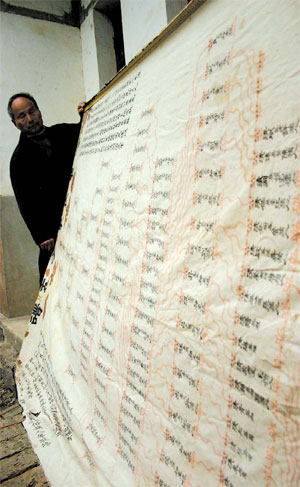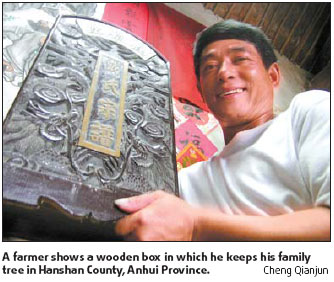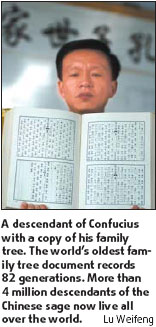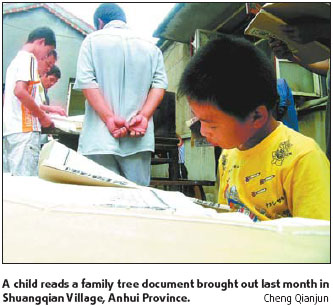Unearthing family roots
 |
| A farmer with Peicun Village of Chaohu City, Anhui Province, displays the village's family tree document. It shows the 19 generations of the Pei family spanning some 700 years. Jin Xueyong |
Huang, who is chairman of the California-based Dazhonghua Family Tree Development Association, admits that the project, which was launched one year ago, will require the cooperation of several generations.
"The combination of modern technology with the Chinese tradition of genealogy is very interesting to me," says Huang, a computer engineer who immigrated to the United States 20 years ago.
Huang says anyone can register on the website (www.dazupu.net) and establish a family tree of his or her own. The creator can also maintain and update the family tree, add text, photos, audio and video files. He or she can choose whether to open part or all of the content to the public.
If a woman, for example, knows the name of the earliest person with her surname and types in the earliest ancestor's name and her own name, she could find a family tree of the clan.
Huang's association has two teams - one working from the present going back and the other team is working from the other direction. Besides Chinese, Huang intends to build versions in other languages including English and French, directed at overseas Chinese who do not read Chinese.

At certain points, family trees of different surnames were also linked with each other.
For example, people surnamed Liu usually regard Liu Xiahui (720-621 BC) as the earliest ancestor with the surname. However, Liu Xiahui's original name was Zhan Huo, and he was called Liu Xiahui because his feudal estate was called Liuxia, while his posthumous title was Hui.
Thus, those with the surnames Liu and Zhan come from the same roots. People surnamed Liu often refer to the family tree of Zhan when they try to build their family tree.
Huang's goal is to gather all the family trees of different surnames to form a Chinese family tree. He has also written a letter to the State Council calling for the listing of genealogy as a national intangible cultural heritage.
"In the building of a Chinese family tree, we can gather the good traditions of many families and form a very good social power," he says.
Huang's work follows a trend in China where many people are seeking to re-establish family trees because many consider genealogy to be an important part of their history. Such interests waned during the second half of the 20th century.
Family tree, called jiapu, zongpu, zupu or pudie in Chinese, is a document showing the lineage and deeds of a family. Chinese family trees can be traced to eras before the Qin Dynasty (221-206 BC). During the Ming (1368-1644) and Qing (1644-1911) dynasties, compiling family trees became a very popular cultural activity.
Genealogy, local annals, and national history are the three major forms of historical documents in China. Scholars of different eras regarded genealogy to be an important knowledge, for it records the lineage, migration, population, marriage and other information. Rituals, etiquette and rules of a family can often reflect historical, customary and cultural aspects of a time.
In the second half of the 20th century, genealogy became "remnants of feudalism" in political movements and was often disposed as garbage. Shanghai Library, which has the largest collection of genealogy information in China, saved 10,000 records of genealogy from being recycled.
However, there's been a renewed interest in genealogy in recent years partly due to economic development and a stable social environment.
Liu Zhe, a 37-year-old man from East China's Zhejiang Province, believes he's a descendant of Liu Xiahui and has spent nearly 20 years collecting family trees of people surnamed Liu. The name accounts for about 0.1 percent of the total population of Han Chinese.

He has collected over 50 family trees, including some of the people surnamed Zhan that are from the same root of the Liu family. One of them, from Yuexi County of East China's Anhui Province, has a preface by the famous ancient writer Liu Zongyuan (AD 773-813) and portraits of more than 40 generations of ancestors.
"I began to read about genealogy when I was in high school. When I learned about such outstanding people in my family as Liu Xiahui, Liu Zongyuan, and Liu Yazi (1887-1958, famous scholar), I decided that I wanted to become an outstanding person like them," says Liu Zhe, who is co-author of a book titled The Distinguished Family of Liu (Liushi Mingmen).
What Liu Zhe read from his family tree included dates of birth and death of ancestors, family rules, poetry by ancestors, and inscriptions on memorial tablets.
"Family tree is a very good medium of cultural transmission. Without it, the mansion of Chinese culture would be incomplete," he says.
More and more Chinese people are compiling their family trees to rebuild their family history.
Pei Xinsheng, 59, from East China's Jiangxi Province, has spent three years and about 200,000 yuan ($26,281) to compile a 1,200-page and 1.6-million-character National Genealogy of the Pei Family (Zhonghua Peishi Zongpu).
Elderly people in Pei's home village used to tell him that the Peis came from North China's Shanxi Province, but could not tell him the details. Pei began to refer to family trees of other families surnamed Pei since his own family tree was fragmented.
After looking at many family trees, Pei found out that his family was originally from the Peibai Village of Shanxi's Wenxi County, where there is still a temple worshipping Pei Jingong, a prime minister of the Tang Dynasty (AD 618-907).
In history, 59 prime ministers and 59 generals came out of the Pei family. This was documented in Genealogy of the Pei Family (Peishi Shipu), one of the largest-scale family trees of the Pei family that was compiled in the Qing Dynasty.
"Many of the famous figures in the history of Pei family were documented in the Genealogy of the Pei Family, but I'm trying to include more common and contemporary people of the Pei family into the new genealogy that I'm compiling," says Pei Xinsheng.
Pei Xinsheng has incorporated more than 100 family trees of people surnamed Pei from provinces of Jiangxi, Hubei, Henan, Shandong, Shanxi and Sichuan into the new genealogy. Moreover, he has also collected family trees of people surnamed Bae from the Republic of Korea, which he believes to be from the same root of the Chinese surname Pei.
Pei Xinsheng used his own money to travel to different places to collect family trees, and advertised in the media inviting all Peis to participate in the compilation of the national genealogy.
"I've succeeded in very few things in my life, but I hope I can contribute to the genealogy of the Pei family," he says.
Besides the work of various individuals, Shanghai Library is compiling the General Catalogue for Chinese Genealogy, which is expected to be completed by the end of this year and be fully accessible to the public by 2008.
"In the 5,000 years of Chinese people's history, they have never forgotten their ancestors. Compiling family trees is becoming more and more popular now," says Yuan Yida, director of the Huaxia Research Center on the Origins of Surnames. "Surnames are the most important mark of identification in China. They represent our blood."
(China Daily 08/14/2007 page19)














